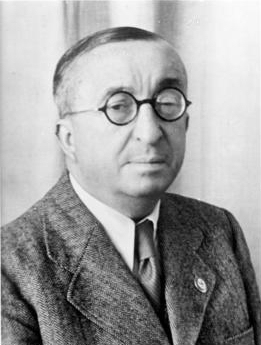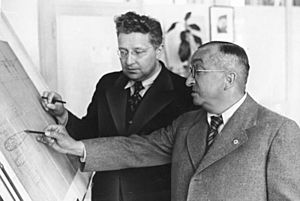Ernst Heinkel facts for kids
Quick facts for kids
Dr. Ernst Heinkel
|
|
|---|---|
 |
|
| Born | 24 January 1888 Grunbach, Kingdom of Württemberg, German Empire
|
| Died | 30 January 1958 (aged 70) |
| Occupation | German aircraft designer and manufacturer |
| Awards | German National Prize for Art and Science (1938) |
Dr. Ernst Heinkel (born January 24, 1888 – died January 30, 1958) was a famous German aircraft designer. He also owned a company that built airplanes. His company, Heinkel Flugzeugwerke, made some very important planes.
They built the Heinkel He 178, which was the world's first plane powered by a turbojet engine. They also created the Heinkel He 176, the first plane to fly using rocket power.
Contents
Becoming an Aircraft Designer
Ernst Heinkel was born in a town called Grunbach. When he was young, he became an apprentice machinist. This means he learned how to work with machines.
He studied at the Technical Academy of Stuttgart. There, he became very interested in flying. He loved Zeppelins, which were huge airships. In 1909, he went to an airshow and decided that flying was the future. The next year, he built his first airplane. Sadly, he crashed it in 1911 and was badly hurt.
Working for Other Companies
After his accident, Heinkel got a job at a company called Luft-Verkehrs Gesellschaft (LVG). They built planes designed by Henri Farman. Later, he moved to another company, Albatros.
During the First World War, planes he designed were used by armies. He designed several planes for the Hansa-Brandenburg company starting in 1914. These included planes that could land on land and planes that could land on water (seaplanes).
Starting Heinkel-Flugzeugwerke
In 1921, Ernst Heinkel became the main designer for a company called Caspar-Werke. But he soon left to start his own company. In 1922, he opened Heinkel-Flugzeugwerke in a town called Warnemünde.
After World War I, Germany was not allowed to build many military aircraft. This was part of the Treaty of Versailles. So, Heinkel looked for work outside Germany. He designed seaplanes that were built in Sweden. He also worked on planes that could be launched from a catapult for the Imperial Japanese Navy. He even put a similar catapult on a large ship, the ocean liner Bremen, to launch mail planes.
Working Around the Rules
Between 1921 and 1924, the Japanese government helped Heinkel. They ordered planes from his company. They also helped him avoid the rules of the Versailles Treaty. This treaty stopped Germany from building military planes. Japan was part of the group that checked on German factories. They would tell Heinkel when inspections were coming. Heinkel would then hide his planes in dunes behind his factory. The inspectors never found them. Heinkel later wrote that this cooperation with Japan lasted for many years.
Building Planes for World War II
When Adolf Hitler came to power in Germany, Heinkel's company became very important. His designs helped build up Germany's air force, the Luftwaffe, before the Second World War. This included famous planes like the Heinkel He 59, the Heinkel He 115, and the Heinkel He 111. He was called a "defence industry leader" by the German government.
Heinkel loved the idea of high-speed flight. He wanted to find new ways to make planes fly faster. He gave planes to Wernher von Braun, who was studying rocket power for aircraft. He also supported Hans von Ohain, who was working on turbojet engines. This research led to the flight of the Heinkel He 178. On August 27, 1939, it became the first plane to fly only with jet power.

Heinkel was a member of the Nazi party. However, he had criticized Hitler's government. In 1933, he was forced to fire Jewish designers and staff. In 1938, he received a special award from the German government. Sadly, his company also used forced labor during the war, starting in 1941.
In 1942, the government took control of Heinkel's factories. Heinkel was held until he sold his share of the factories to Hermann Göring. Heinkel then moved to Vienna and started new design offices. He set up new factories there, called the Heinkel-Sud complex. The original factory became the Heinkel-Nord facility. In Vienna, Dr. Heinkel worked on new bomber designs until the war ended.
After the War
In July 1945, American soldiers captured Heinkel. He was held for a while at Kransberg Castle. After the war, Germany was not allowed to build aircraft. So, Heinkel used his factories to make other things.
In 1953, Heinkel started making the Tourist scooter. Then, in 1954, he made the Perle moped. In 1956, he introduced the Heinkel Kabine bubble car, a very small car. When Germany was allowed to build aircraft again, he stopped making bubble cars and mopeds. But scooter production continued until 1965.
Death and Legacy
Ernst Heinkel died in 1958 in Stuttgart. His life story, called Stürmisches Leben, was published in 1956. It was later translated into English as Stormy Life: Memoirs of a Pioneer of the Air Age.
In 1981, Ernst Heinkel was honored. He was added to the International Air & Space Hall of Fame at the San Diego Air & Space Museum.
See also
 In Spanish: Ernst Heinkel para niños
In Spanish: Ernst Heinkel para niños


